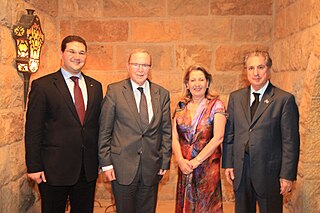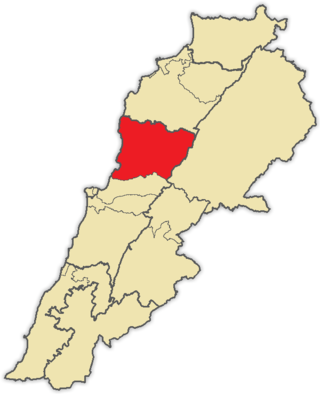
Nadim Bachir Gemayel is a Lebanese politician, mostly known for being the son of former Lebanese president-elect Bachir Gemayel. He is a member of the Kataeb party that was founded by his grandfather Pierre Gemayel.

Beirut II was a parliamentary constituency in Lebanon. It covered three neighbourhoods (quartiers) in the north-eastern parts of the capital; Port, Medawar and Bachoura. The constituency elected four members of the National Assembly. Two of the Beirut II MPs had to be Armenian Orthodox, 1 Sunni Muslim and 1 Shia Muslim. The constituency was created with the 2008 Doha Agreement, ahead of the 2009 parliamentary election.

General elections were held in Lebanon on 6 May 2018. Although originally scheduled for 2013, the election was postponed three times in 2013, 2014 and 2017 for various reasons, including the security situation, the failure of the Parliament to elect a new President, and the technical requirements of holding an election. A new electoral law adopted in 2017 provides a proportional representation system for the first time.

In Lebanese politics Minorities is a term that includes six different Christian sects; Syriac Orthodox, Syriac Catholics, Assyrian Church of the East, Chaldean Catholics, Latin Catholics and Coptic Orthodox. 1 of the 128 seats in the national parliament is allocated to Minorities. The Minorities' seat is elected from Beirut III electoral district, an electoral district with a large Sunni Muslim majority.

Beirut I is an electoral district in Lebanon. The district elects eight members of the Lebanese National Assembly – three Armenian Orthodox, one Armenian Catholic, one Greek Catholic, one Greek Orthodox, one Maronite and one Minorities.

Beirut II is an electoral district in Beirut, Lebanon, as per the 2017 vote law. The district elects 11 members of the Lebanese National Assembly - 6 Sunnis, 2 Shias, 1 Druze, 1 Greek Orthodox, 1 Evangelical.

Bekaa I is an electoral district in Lebanon, as per the 2017 vote law. The district elects 2 Greek Catholic parliamentarians, 1 Maronite, 1 Greek Orthodox, 1 Armenian Orthodox, 1 Shia and 1 Sunni. The electoral district covers the qada of Zahle. The electoral district retained the geographic boundaries and seat allocation of the Zahle electoral district from the previous electoral law.
A total of 583 candidates contested the 2018 Lebanese general election, running on 77 lists.

Mount Lebanon I is an electoral district in Lebanon, as per the 2017 vote law. The district elects 8 members of the Lebanese National Assembly - 7 Maronites and 1 Shia. The constituency contains two 'minor districts', Byblos and Kesrwan. The Byblos 'minor district' elects 2 Maronite and 1 Shia parliamentarian, whilst the Kesrwan 'minor district' elects 5 Maronite parliamentarians.

Mount Lebanon IV is an electoral district in Lebanon, as per the 2017 vote law. The district elects 13 members of the Lebanese National Assembly - 5 Maronites, 4 Druze, 2 Sunni, 1 Greek Catholic and 1 Greek Orthodox. The constituency contains two 'minor districts', Aley and Chouf. The Aley 'minor district' elects 2 Druze, 2 Maronite and 1 Greek Orthodox parliamentarian, whilst the Chouf 'minor district' elects 3 Maronite, 2 Druze, 2 Sunni and 1 Greek Catholic parliamentarians.

North II is an electoral district in Lebanon, as per the 2017 vote law. The district elects 11 members of the Lebanese National Assembly - 8 Sunni, 1 Alawite, 1 Greek Orthodox and 1 Maronite. The constituency contains three 'minor districts', Tripoli, Miniyeh and Danniyeh. The Tripoli 'minor district' elects 5 Sunnis, 1 Alawite, 1 Greek Orthodox and 1 Maronite parliamentarian, the Miniyeh 'minor district' elects 1 Sunni and the Danniyeh 'minor district' elects 2 Sunni parliamentarians.

North III is an electoral district in Lebanon, as per the 2017 vote law. The district elects 10 members of the Lebanese National Assembly - 7 Maronites and 3 Greek Orthodox. The constituency contains four 'minor districts', Batroun, Bcharre, Koura and Zghorta.
A total of 718 candidates contested the 2022 Lebanese general election, running on 103 lists.

Voting to elect eleven members of the Lebanese parliament took place in the Beirut II district on 6 May 2018, part of the general election of that year. The constituency had 353,164, out of whom 143,829 voted. Residents elect 6 Sunnis, 2 Shias, 1 Druze, 1 Greek Orthodox and 1 Evangelical.

Voting to elect seven members of the Lebanese parliament took place in the Bekaa I district on 6 May 2018, part of the general election of that year. The constituency had 172,555 voters, out of whom 94,082 voted. The district elects 2 Greek Catholic parliamentarians, 1 Maronite, 1 Greek Orthodox, 1 Armenian Orthodox, 1 Shia and 1 Sunni.

Voting to elect six members of the Lebanese parliament took place in the North I district on 6 May 2018, part of the general election of that year. The constituency had 137,550 who voted. The district elects 3 Sunni, 2 Greek Orthodox, 1 Maronite, 1 Alawite. It covers the Akkar district.

Voting to elect eleven members of the Lebanese parliament took place in the South III district on 6 May 2018, part of the general election of that year. The constituency had 460,565 voters, out of whom 228,563 voted. The district elects 8 Shiite parliamentarians, 1 Druze, 1 Greek Orthodox and 1 Sunni.

Voting to elect eight members of the Lebanese parliament took place in the Mount Lebanon I district on 6 May 2018, part of the general election of that year. The constituency had 176,818 registered voters, out of whom 115,619 voted.

Voting to elect eleven members of the Lebanese parliament took place in the North II district on 6 May 2018, part of the general election of that year. The constituency had 350,147 registered to vote, out of whom 146,419 voted. Residents elect 8 Sunni, 1 Alawite, 1 Greek Orthodox and 1 Maronite seat. The constituency contains three 'minor districts', Tripoli, Miniyeh and Danniyeh.

Voting to elect eight members of the Lebanese parliament took place in the Beirut I district on 15 May 2022, part of the general election of that year. The constituency had 134,886 registered voters out of whom 48,311 voted.





















